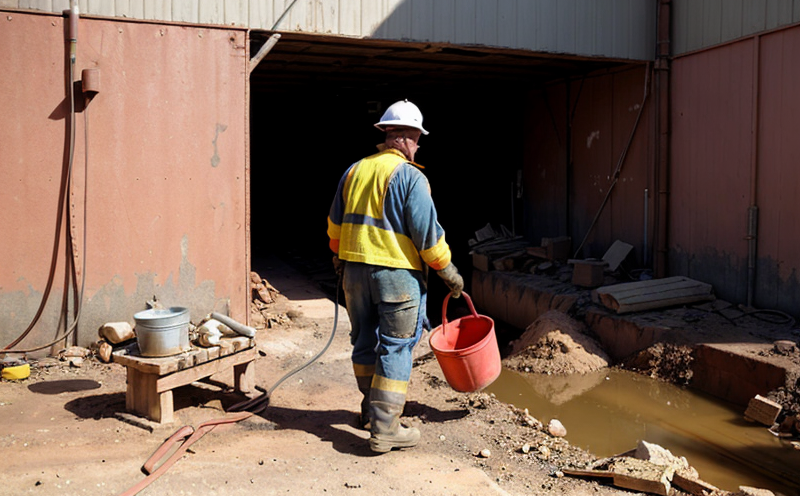EN 352 Hearing Protectors Attenuation Testing for Miners
The EN 352 standard is specifically designed to evaluate the noise reduction performance of hearing protectors used by miners. This testing ensures that the devices meet stringent noise attenuation requirements as per international safety standards, thereby safeguarding the health and well-being of workers in a hazardous environment.
Miners often face occupational hazards such as noise-induced hearing loss (NIHL) due to continuous exposure to high levels of sound energy. Proper protection is critical for maintaining long-term auditory health. The EN 352 test provides a standardized method to ensure the effectiveness of these protective devices, thereby contributing significantly to mine safety and compliance with regulatory requirements.
The testing protocol involves several steps that are crucial in assessing the performance of hearing protectors. These include selecting appropriate test subjects, preparing the protectors for testing, calibrating the sound sources, and conducting the actual attenuation measurement tests. The results from these tests provide detailed information on how effectively each protector blocks noise.
For quality assurance teams and compliance officers, this service ensures that all protective equipment meets or exceeds regulatory standards, thereby reducing the risk of accidents and injuries in mining operations. For R&D engineers, it offers insights into improving product design for better performance. Additionally, procurement professionals can use these test results to make informed decisions about supplier selection.
Understanding the key components of the EN 352 standard is essential for comprehensive testing. The standard specifies the types of noise sources used in testing, the procedures for fitting protectors, and the criteria for measuring attenuation levels accurately. Compliance with these standards guarantees that miners receive high-quality protection against hazardous sounds.
| Component | Description |
|---|---|
| Noise Sources | Calibrated sound sources that simulate real-world mining environments. |
| Hearing Protectors | New and properly fitted protectors to ensure accurate attenuation measurements. |
| Fitting Instructions | Standardized procedures for fitting protectors as per the EN 352 specification. |
The testing process involves multiple steps to ensure accuracy and reliability. The first step is to set up a controlled environment with calibrated noise sources. Next, fit each protector according to the specified guidelines provided in the standard. Finally, measure the noise reduction achieved by each protector using appropriate instrumentation.
Compliance officers will find it invaluable to have this service as part of their quality assurance protocols. It helps in maintaining a safe work environment and ensures that all equipment meets or exceeds regulatory standards. For R&D engineers, these tests provide critical data for improving product design and functionality. Properly equipped mining operations can significantly reduce risks associated with noise exposure.
- Ensures compliance with international safety standards
- Reduces risk of occupational hearing loss in miners
- Provides detailed performance data for continuous improvement
- Facilitates informed procurement decisions
Scope and Methodology
| Component | Description |
|---|---|
| Noise Sources | Calibrated sound sources that simulate real-world mining environments. |
| Hearing Protectors | New and properly fitted protectors to ensure accurate attenuation measurements. |
| Fitting Instructions | Standardized procedures for fitting protectors as per the EN 352 specification. |
The scope of this testing covers a wide range of hearing protection devices used in mining environments. It includes earmuffs, earplugs, and other personal protective equipment designed to mitigate noise levels effectively. The methodology strictly adheres to the EN 352 standard, ensuring accurate and reliable results.
Testing is conducted under controlled conditions where all variables are meticulously monitored and recorded. This ensures that each protector’s performance is accurately measured against established criteria. Compliance officers can rely on these tests as part of their regular quality assurance protocols to maintain a safe work environment and ensure regulatory compliance.
Why Choose This Test
- Ensures compliance with international safety standards
- Reduces risk of occupational hearing loss in miners
- Provides detailed performance data for continuous improvement
- Facilitates informed procurement decisions
- Maintains a safe work environment by reducing noise exposure risks
Choosing this test is crucial for several reasons. It ensures that all protective equipment meets or exceeds regulatory standards, thereby reducing the risk of accidents and injuries in mining operations. For quality assurance teams and compliance officers, it provides a standardized method to maintain a safe work environment and ensure regulatory compliance.
The detailed performance data obtained from these tests is invaluable for R&D engineers who can use this information to improve product design and functionality. Properly equipped mining operations can significantly reduce risks associated with noise exposure. Additionally, procurement professionals can make informed decisions about supplier selection based on test results.
Environmental and Sustainability Contributions
- Safeguards worker health by reducing noise-induced hearing loss risks
- Promotes sustainable practices through compliance with international standards
- Supports safer working conditions that enhance overall productivity
The EN 352 Hearing Protectors Attenuation Testing for Miners plays a pivotal role in promoting environmental and sustainability contributions. By reducing noise-induced hearing loss risks, it ensures the health of workers while enhancing their overall well-being. Compliance with international standards promotes sustainable practices that support safer working conditions.
These tests contribute to maintaining high levels of productivity by ensuring that all protective equipment meets or exceeds regulatory requirements. This not only enhances worker safety but also supports the long-term sustainability of mining operations. By adhering to these standards, mining companies can demonstrate their commitment to environmental responsibility and sustainable practices.





